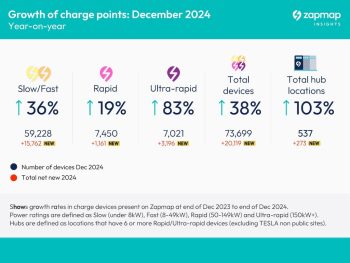Electric vehicle charge point installations in the UK have seen annual record growth again, with the rollout of ultra-rapid chargers and charging hubs particularly surging.

More than 20,000 new charge points were installed throughout 2024, bringing the total number across the country to 73,699 – up 38% year on year. The rate of installation of charge points has also grown from an average of 1,400 per month to 1,650 per month.
The highest growth was seen in ultra-rapid (150kW+) devices; up 84% since the end of 2023. These devices are being rolled out at charging hubs at motorway service areas and also varied locations such as retail parks, car parks and farm shops. There are more than 7,000 150kW+ chargers, with a total of more than 14,000 over 50kW now available, while the number of hubs (six or more 50kW chargers) rose from 264 at the end of 2023 to 537 at the end of 2024.
The National Audit Office reported in December that the number of public charge points was on track to meet Government targets by 2030 but warned that major challenges remain on issues such as regional disparities.
But Zapmap said its charging statistics show encouraging growth across all the charging use cases; from the en-route chargers referenced above, through to destination and on-street chargers, and with progress being made in addressing regional inequalities.
Destination chargers – which enable EV drivers to charge while they stop, rather than stopping to charge – continue to be boosted across the UK. There are 12,000 additional chargers now available at destinations such as restaurants, hotels, retail car parks and leisure areas across the UK.
On-street charger rollout, which supports EV drivers without off-street parking, has also grown, but 72% of these chargers are concentrated in Greater London. Many other areas such as Coventry and Liverpool also have good local availability, but overall provision at a local level is still variable.
However, with the LEVI (Local Electric Vehicle Infrastructure) government-funded projects starting to come to fruition, there should be a more equitable distribution of on-street charging provision towards the end of 2025, according to Zapmap.
Simultaneously, statistics from its EV charging points app show significant progress in the distribution of en-route chargers outside London this year: nine out of 12 geographical areas of the UK now have over 1,000 50kW+ chargers.
But Wales and the North West continue to be less well covered – although they have made good progress over the course of 2024 – while the pace of installations in Northern Ireland continues to lag.
Zapmap’s new charging statistics follow this week’s SMMT announcement of record sales of new pure electric cars in 2024. More than 380,000 fully electric cars were sold in the UK last year, more than 19% of all new cars sold in 2024. The total number of fully electric cars on the UK’s roads now stands at 1,360,802; up from 978,832 at the end of 2023, representing a 39% growth in the parc.
Zapmap also published findings from its annual driver survey in December, showing an average satisfaction rating of 87% for drivers of electric cars, with fewer than 3% saying they would return to a petrol or diesel car.

While 79% of respondents have a dedicated home charger, 51% of EV drivers use the public network at least once per month, reflecting the continued importance of public infrastructure.
Zapmap data also reveals that by the end of 2024, over 2.5 million successful charge sessions were completed in a month, reflecting both the improvement in reliability and the significant overall growth in charging infrastructure, which has increased by 38% over the last 12 months.
Melanie Shufflebotham, co-founder and COO at Zapmap, said: “Last year was another record year for charging infrastructure growth with en-route charging points in particular being installed ahead of the growth in electric vehicle sales.
“As we move into 2025, we can expect to see the benefits of the PCPR consumer regulations coming into effect combined with the impact of LEVI-funded projects reaching local authorities and bringing more equitable access to charging devices.
“Confirmation on a strong and clear ZEV mandate, following the Government’s recently communicated consultation, will also help to bring certainty and confidence to both infrastructure providers and UK drivers that the transition is happening now.”

